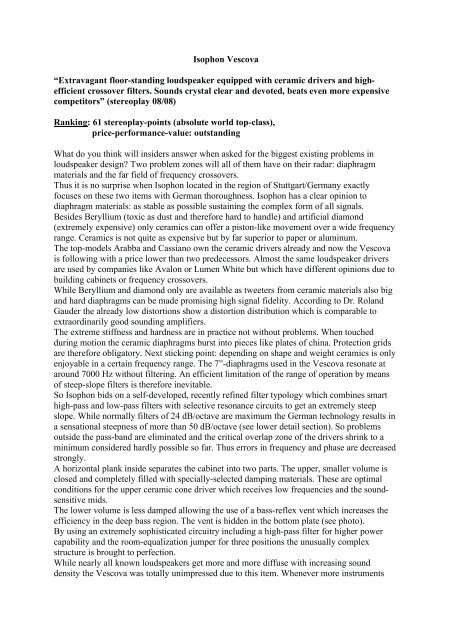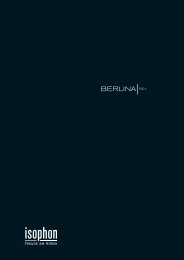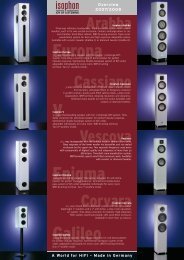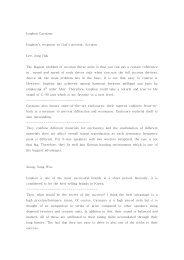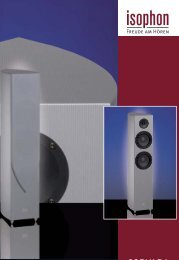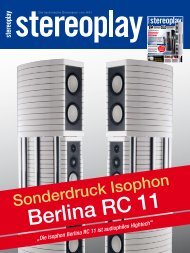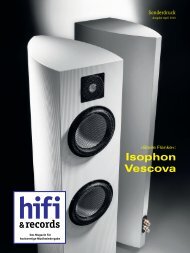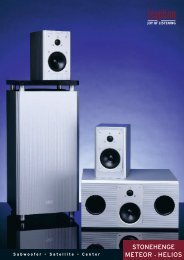Isophon Vescova âExtravagant floor-standing loudspeaker equipped ...
Isophon Vescova âExtravagant floor-standing loudspeaker equipped ...
Isophon Vescova âExtravagant floor-standing loudspeaker equipped ...
Create successful ePaper yourself
Turn your PDF publications into a flip-book with our unique Google optimized e-Paper software.
<strong>Isophon</strong> <strong>Vescova</strong><br />
“Extravagant <strong>floor</strong>-<strong>standing</strong> <strong>loudspeaker</strong> <strong>equipped</strong> with ceramic drivers and highefficient<br />
crossover filters. Sounds crystal clear and devoted, beats even more expensive<br />
competitors” (stereoplay 08/08)<br />
Ranking: 61 stereoplay-points (absolute world top-class),<br />
price-performance-value: out<strong>standing</strong><br />
What do you think will insiders answer when asked for the biggest existing problems in<br />
<strong>loudspeaker</strong> design? Two problem zones will all of them have on their radar: diaphragm<br />
materials and the far field of frequency crossovers.<br />
Thus it is no surprise when <strong>Isophon</strong> located in the region of Stuttgart/Germany exactly<br />
focuses on these two items with German thoroughness. <strong>Isophon</strong> has a clear opinion to<br />
diaphragm materials: as stable as possible sustaining the complex form of all signals.<br />
Besides Beryllium (toxic as dust and therefore hard to handle) and artificial diamond<br />
(extremely expensive) only ceramics can offer a piston-like movement over a wide frequency<br />
range. Ceramics is not quite as expensive but by far superior to paper or aluminum.<br />
The top-models Arabba and Cassiano own the ceramic drivers already and now the <strong>Vescova</strong><br />
is following with a price lower than two predecessors. Almost the same <strong>loudspeaker</strong> drivers<br />
are used by companies like Avalon or Lumen White but which have different opinions due to<br />
building cabinets or frequency crossovers.<br />
While Beryllium and diamond only are available as tweeters from ceramic materials also big<br />
and hard diaphragms can be made promising high signal fidelity. According to Dr. Roland<br />
Gauder the already low distortions show a distortion distribution which is comparable to<br />
extraordinarily good sounding amplifiers.<br />
The extreme stiffness and hardness are in practice not without problems. When touched<br />
during motion the ceramic diaphragms burst into pieces like plates of china. Protection grids<br />
are therefore obligatory. Next sticking point: depending on shape and weight ceramics is only<br />
enjoyable in a certain frequency range. The 7”-diaphragms used in the <strong>Vescova</strong> resonate at<br />
around 7000 Hz without filtering. An efficient limitation of the range of operation by means<br />
of steep-slope filters is therefore inevitable.<br />
So <strong>Isophon</strong> bids on a self-developed, recently refined filter typology which combines smart<br />
high-pass and low-pass filters with selective resonance circuits to get an extremely steep<br />
slope. While normally filters of 24 dB/octave are maximum the German technology results in<br />
a sensational steepness of more than 50 dB/octave (see lower detail section). So problems<br />
outside the pass-band are eliminated and the critical overlap zone of the drivers shrink to a<br />
minimum considered hardly possible so far. Thus errors in frequency and phase are decreased<br />
strongly.<br />
A horizontal plank inside separates the cabinet into two parts. The upper, smaller volume is<br />
closed and completely filled with specially-selected damping materials. These are optimal<br />
conditions for the upper ceramic cone driver which receives low frequencies and the soundsensitive<br />
mids.<br />
The lower volume is less damped allowing the use of a bass-reflex vent which increases the<br />
efficiency in the deep bass region. The vent is hidden in the bottom plate (see photo).<br />
By using an extremely sophisticated circuitry including a high-pass filter for higher power<br />
capability and the room-equalization jumper for three positions the unusually complex<br />
structure is brought to perfection.<br />
While nearly all known <strong>loudspeaker</strong>s get more and more diffuse with increasing sound<br />
density the <strong>Vescova</strong> was totally unimpressed due to this item. Whenever more instruments
played or the listening level was increased the <strong>Vescova</strong> show the additional sound sources.<br />
Veil or sound-masking? Not with this speaker!<br />
The reviewers went through all human emotions listening to the <strong>Vescova</strong>, from heartbeat via<br />
goose-bumps to big consternation when listening to long-know favorite tracks. The<br />
shockingly free clarity remained until the mechanical limits of the drivers suddenly turned<br />
into hardness – a clue that many <strong>loudspeaker</strong>s compress much earlier. Apropos power<br />
handling: It was only seldom that the reviewers had had the opportunity to enjoy such a<br />
voluminous, powerful and though precise bass even in much higher price-classes. The<br />
impression of phenomenal stability and certainty was coupled with a holographically precise<br />
imaging which helped to unmask recording errors or caused astonishment how crooked and<br />
diffuse some speakers sound. While competitors in the same price-region sounded similarly<br />
confident and neutral they were without any chance as soon as music got more and more<br />
complex. Even the high-ranked <strong>loudspeaker</strong> „Ambiance“ from Audiodata sounded lethargic<br />
and irritated compared to the <strong>Isophon</strong>. Without any doubt the <strong>Vescova</strong> is an exceptional<br />
sound-transducer of highest class. Besides this it looks really beautiful!<br />
Anyone who is addicted to <strong>loudspeaker</strong> design knows that wish and reality are far apart each<br />
other concerning the function of frequency crossovers. Everything looks pretty easy and<br />
simple. From a theoretic point of view two components (a capacitor and an inductor) are<br />
sufficient to create a filter of second order which is the by far most often used application. In<br />
every sophisticated construction manual you can find the necessary formulae to calculate the<br />
components` values. Butterworth- or Bessel characteristics is only a matter of mathematics.


